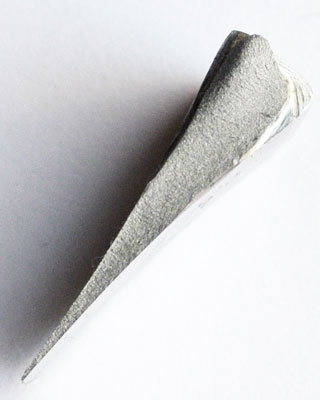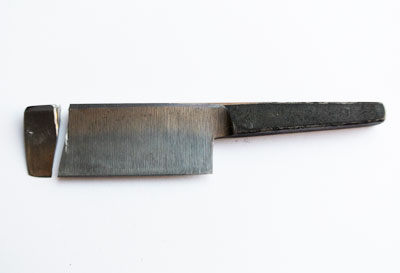Results 51 to 60 of 77
-
02-11-2015, 05:39 PM #51

It is logical, thank you. If all goes well, tomorrow or the day after tomorrow I will publish the fourth attempt...
Last edited by gregg71; 02-11-2015 at 07:17 PM.
gregg
-
02-11-2015, 08:42 PM #52

Mike, I just read it more carefully. Maybe I used the wrong term: normalizing.
This is my process from SRP's pdf:
"To normalize, I heat the steel to 1450 F, hold it there for a couple of minutes, then take it out of the
forge and allow it to cool until itís black again. This takes about two or three minutes. The color is all
gone by the time the steel reaches about 800 F or so, and then itís back into the forge again. I normalize
three times."
The thermal cyling a little bit faster but the same process, isn't it? I'm sorry if I ask stupid. gregg
gregg
-
02-11-2015, 08:46 PM #53aka shooter74743




- Join Date
- Sep 2009
- Location
- SE Oklahoma/NE Texas
- Posts
- 7,285
- Blog Entries
- 4
Thanked: 1936
Gregg,
Don't worry about what "system" you post your temps in, the metric system is a much better system for sure for my simple brain.Southeastern Oklahoma/Northeastern Texas helper. Please don't hesitate to contact me.
Thank you and God Bless, Scott
-
The Following User Says Thank You to ScottGoodman For This Useful Post:
gregg71 (02-11-2015)
-
02-13-2015, 11:47 AM #54

I finished the fourth attempt as well.
Fourth attempt
edge 1 mm
normalizing: none
thermal cycling: 1472F (800C), three times, in 130F (55C) warm oil 2-3 sec.
soaking: 1472F (800C), 15 min.
quenching oil: 120F (50C), 10-15 sec.
tempering: after cool enough to touch, 420F (215C), 2x1h (between cooling to room temperature)

I was able to shave with the razor pretty well, but the grain size does not change compared to the previous experiment. I'm not surprised because I think the thermal cyling a little bit faster but the same process than my previous normalization. Correct me if I'm wrong, please!
What else can I do to reduce the particle size?
update:
I can even try the following:
- Shorter soaking time (5 minutes), as suggested by Mike.
- I work at a lower temperature (10-20C) for two reasons:
1. The +14C(57F) overtemperature is maybe too much.
2. The oven's temperature display is not accurate. (less likely)Last edited by gregg71; 02-13-2015 at 03:41 PM.
gregg
-
The Following User Says Thank You to gregg71 For This Useful Post:
ScottGoodman (02-13-2015)
-
02-13-2015, 12:01 PM #55

Wow, so you made a razor, honed it, shaved with it then snapped it! Good effort

How confident are you that your thermocouple is accurate?
-
The Following User Says Thank You to mikew For This Useful Post:
gregg71 (02-13-2015)
-
02-13-2015, 12:22 PM #56

I made a couple of mini-razor for this purpose. These are not wellworked. I want to be good at the heat tempering.

"How confident are you that your thermocouple is accurate?" - I dont know. Actually I dont have tool to measure it. This is a second hand oven but theoretically should work fine. When I use my oven on higher temperature(1450-1500F) the stability is between +14C(57F) and -5C(41F) from adjusted value.Last edited by gregg71; 02-13-2015 at 12:24 PM.
gregg
-
02-13-2015, 12:41 PM #57

It sounds to me like you need to invest in a thermocouple.
-
02-13-2015, 12:49 PM #58

I also get the feeling.
 gregg
gregg
-
02-13-2015, 12:57 PM #59

I'm not sure exactly what you will need for your oven but I've used these for a while: https://www.tcdirect.co.uk/Default.a...tment_id=190/2 and you can get a cheap digital readout on evilbay.
-
The Following User Says Thank You to mikew For This Useful Post:
gregg71 (02-13-2015)
-
02-13-2015, 07:20 PM #60"My words are of iron..."


- Join Date
- Oct 2006
- Posts
- 1,898
Thanked: 995
Mikew: I like those thermocouples. K type with iconel sheaths is what I use and the prices are fair for what you get.
Gregg...maybe less soak time (5 minutes) will do the job at 800C.
It's also easier to temper at a lower temperature and dial in hardness by increasing the temperature on the next cycle than to start too high. Try 190C for one to two hours and see what you get. You can always repeat a temper cycle at 5-10C increments to approach the hardness you want. Tempering should not affect grain structure, that's all on the high temperature side of the process.
All this being said, I would suspect that very few shavers will ever test one of your blades to the breaking point except by accident. If you are getting good shaves from your razors, does the grain size make all that much difference? If not, make good razors and remain curious in your own shop but don't worry about the customers. All they want is a good handmade shave. If the honers grumble that your razors eat their stones, now then, you're making very good razors. Ha!
-


 13Likes
13Likes LinkBack URL
LinkBack URL About LinkBacks
About LinkBacks






 Reply With Quote
Reply With Quote

